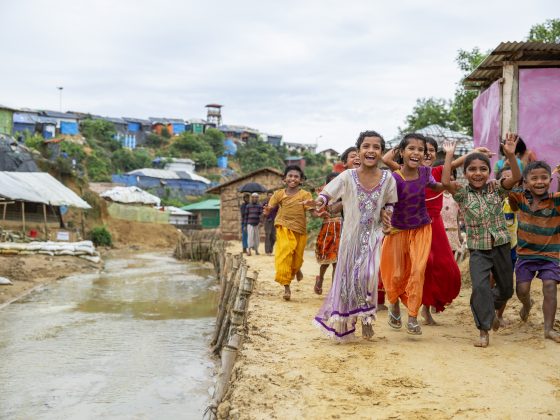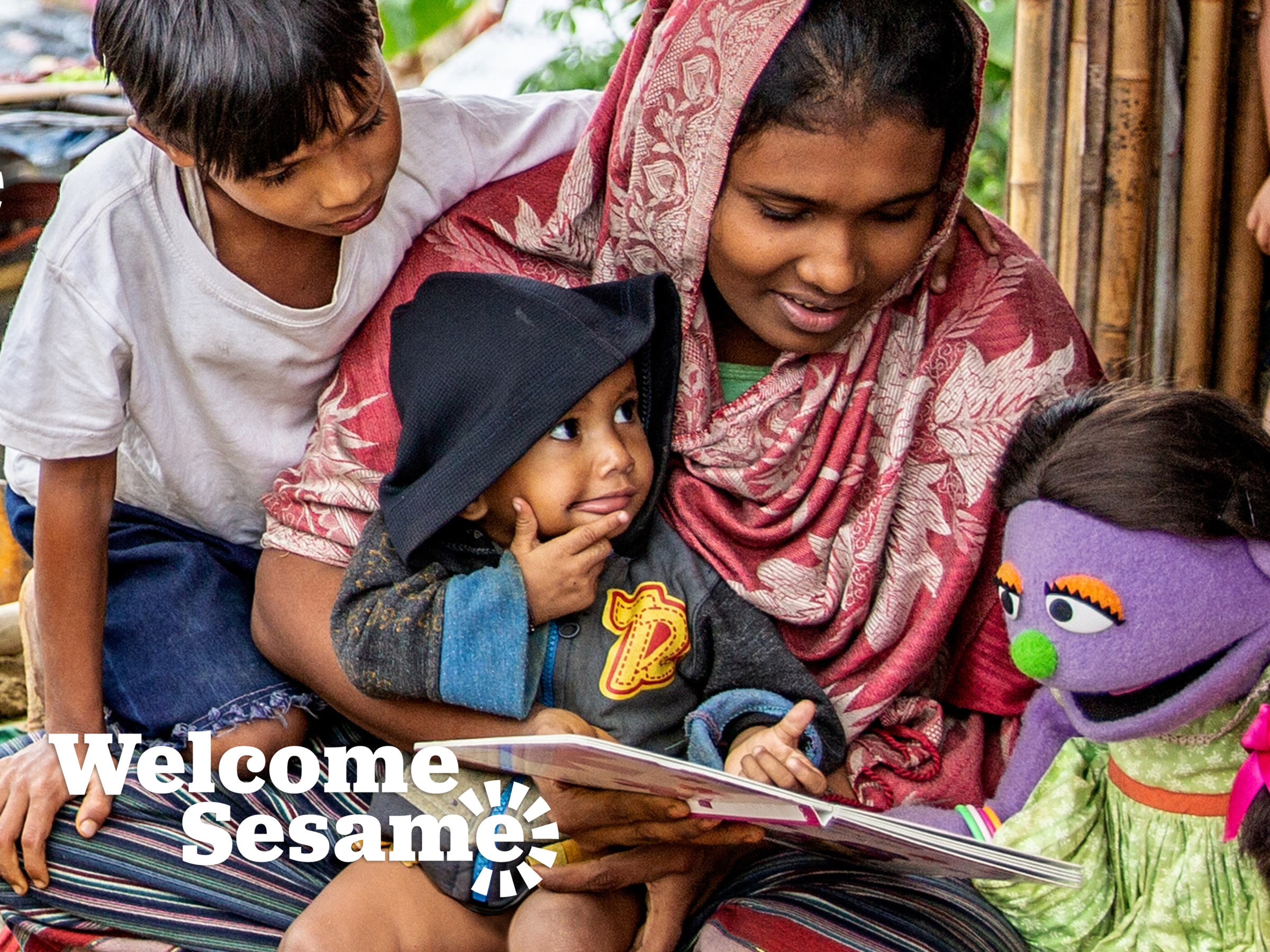
Humanitarian response in human terms: New learnings about how to support young children affected by crises
Sesame and partners discuss challenges, best practices, and recommendations for humanitarian response to better support the youngest and most marginalized populations.
Humanitarian actors widely acknowledge that well-coordinated and holistic support for all people affected by crises is both an essential and, as yet, still incomplete ambition of the humanitarian system. Responses large and small continue to be segmented and struggle with addressing the disproportionate impacts of crises on the youngest and most marginalized populations. During Humanitarian Networks and Partnerships Weeks (HNPW) 2023, Sesame Workshop hosted two virtual panels to ignite the conversation on lessons learned and recommendations for promoting humanitarian responses that meet the needs of all people in a more coordinated and inclusive way. Key take-aways and videos of each panel are presented below.
From a Cohort to Coherence: Mainstreaming Multi-Cluster Coordination of Early Childhood Development and Other Cross-Cutting Issues at the Country Level
Bringing together all the components of early childhood development (ECD) – including health, nutrition, WASH, protection, and education – is a unique challenge, especially in emergencies. But there are ECD in emergencies (ECDiE) coordinators around the world doing great work that we can learn from. That’s why Sesame Workshop and the University of Virginia’s Humanitarian Collaborative launched a learning cohort that brings together ECDiE coordinators working in six countries – Bangladesh, Colombia, Jordan, Syria, Uganda, and Ukraine – to exchange lessons learned from their work. This HNPW panel featured Lisa Doughten from the United Nations Office for the Coordination of Humanitarian Affairs (OCHA) in conversation with three members of the ECDiE Coordinator Learning Cohort:
- Abdur Rahman Khan from Plan International Bangladesh, representing the ECD Working Group in Cox’s Bazar
- Mohammad Abu Ghosh from the International Rescue Committee Syria Team, representing the ECD Syrian Network
- Rogers Golooba from the Ministry of Gender, Labour, and Social Development in Uganda; representing the National ECD Technical Working Group
Abdur Rahman Khan stressed the need for coordination across humanitarian agencies, donors, and governments to support young children in the Rohingya refugee camps and host communities. The ECD Working Group in Cox’s Bazar is a prime example of coordinated efforts that bring together local, international, and cross-sectoral leaders. The four objectives of the ECD Syrian Network—presented by Mohammed Abu Ghosh—feature many of the same elements for coordination. These include collaboration, capacity-building, program implementation, and advocacy. Moreover, securing seed funding for local organizations to integrate ECD was particularly important in the Syrian context. Rogers Golooba echoed the need for guidance to national-level planning authorities and local district governments to identify, plan, and budget for ECD needs and services.
Key takeaways: Where we are and where we’re heading
- ECD is underprioritized and underfunded. ECD is rarely seen as lifesaving in the traditional sense, which makes it difficult to prioritize and fund, especially in acute emergencies. For example, the ECD Syrian Network succeeded in promoting prioritization of ECD in the ongoing response to the protracted Syrian conflict, particularly in the education and protection sectors, but the network needed to redouble its efforts to advocate for ECD prioritization in the response to the earthquakes in February 2023.
- Inclusion of ECD in needs assessments and response plans is essential. The specific needs of young children and their caregivers must be explicitly assessed and reflected in response plans to ensure that funding is requested at the appropriate levels to meet these needs. The ECD Working Group in Cox’s Bazar coordinates across sectors to ensure an integrated approach to strengthening inclusion of ECD in the needs assessment overview and Rohingya Humanitarian Crisis Joint Response Plan.
- Funding is crucial. One of the greatest challenges in ECD coordination is lack of funding, and recent trends show a dip in financing. This adversely affects the quality of services provided, the capacity of operations, and the daily livelihoods of those affected (food insecurity, for instance). Innovative streams of funding (philanthropy, results-based financing) could help fill the current gap.
- Investing in coordination has a multiplier effect. Investing in cross-sectoral coordination is just as important as investing in specific services under each sector because coordination makes the response more efficient and multiplies the impact of our investments.
- Collaboration between the humanitarian system and governments promotes coherence and sustainability. In Uganda, the National ECD Technical Committee brings together relevant government ministries as well as humanitarian and development partners to oversee implementation of all ECD services, including targeted interventions for the most at-risk communities. Leveraging such national coordination mechanisms makes ECD services more coherent and sustainable.
Watch the session recording below.
Cross-cutting or crossed out? How the humanitarian system falls short on population specific issues and how we can work toward a more people-centered system
This panel focused on the specific challenges that some of the most frequently marginalized populations – the oldest and youngest crisis-affected people, LGBTQI+ individuals, and people with disabilities – face as a result of siloed programming. A more holistic, inclusive system that meets the inter-related requirements of every individual affected by crisis is possible, and experts joined the conversation to highlight both current challenges as well as emerging best practices. The panel was moderated by Rachel Maher, the Accountability to Affected People Advisor for OCHA and the Inter-Agency Standing Committee in Geneva. Speakers included:
- Luciana Caffarelli, Global Humanitarian Age Inclusion Advisor at HelpAge International
- Amie Bishop, Director of Humanitarian and Global Development Programs at Outright International
- Alex Gray, Director of International Funds at the Center for Disaster Philanthropy
- Carlos del Castillo, Executive Director of Bases Sólidas, and an advisor for Sesame Workshop in Colombia
- Ulrike Last, Inclusive Humanitarian Action Specialist with Humanity and Inclusion
The panel began with a focus on recent response efforts in Ukraine, drawing our examples of the challenges that older people and LGBTQI+ individuals are experiencing in even a well-funded and coordinated response. Luciana Caffarelli highlighted that while almost one quarter of the population in Ukraine is over the age of 60, many do not have access to assistive devices and are left behind under current ‘digital-heavy’ interventions. Amie Bishop showcased the emergency grant for local LGBTQI+ organizations and efforts to document and strengthen humanitarian response as prime examples of inclusive aid, while noting the troubling absence of locally-led LGBTQI+ organizations on global lists of pre-approved partners.
Despite recurring challenges of inclusion, there are opportunities for funders to address key gaps. From the Center of Disaster Philanthropy, Alex Gray shared insights on the value of capacity-strengthening and research funding as prime examples of funders’ unique standpoint for inclusivity. New pilot programs, for instance, are underway to test programming and coordination mechanisms designed to promote greater inclusion.
Moreover, experts from the field shared other examples of good practice in promoting inclusion, highlighting next steps and recommendations. Carlos del Castillo from Sesame Workshop shared from his experience in Colombia on the intersectoral approach to ECD. He highlighted the success of the government’s whole-child approach and the way that has supported more effective and holistic humanitarian support for other children in the country. The final speaker of the panel, Ulrike Last, drew attention to disability inclusion and how the inclusion of new guidelines in the humanitarian program cycle has supported more inclusive responses.
Rachel Maher offered a helpful summary of the remarks and recommendations for more people-centered programming approaches.
Key take-aways: Where we are and where we’re heading
- Context matters. Humanitarian organizations at large need to understand the pre-existing norms and the social and legal environments as crucial to defining interventions. Sensitivity to how crises differently impact marginalized communities should shape the humanitarian sector.
- Representation at the decision-making level. Marginalized groups and their needs should be represented and advocated for at all decision-making levels of humanitarian response. The most recent Ukraine humanitarian fund call for $70 million, for instance, evidences the lack of LGBTQI+ representation since not one local organization specific to this issue was pre-approved among 129 others.
- Reliance on existing local and civil society organization is critical. Humanitarian actors must make a concerted effort to engage with local organizations working on the same issues. Elevating communities’ voices to address the root causes of exclusion is pivotal to changing the current humanitarian landscape.
- Philanthropic funding can help bridge the gap. Where the traditional humanitarian system falls short, philanthropic funding can support individuals’ needs through flexible funding, higher risk tolerance, and innovation support.
- There is increasing appetite for something like an Inclusion Coalition. Spaces like the panel at HNPW bring together humanitarian actors keen on advocating for better practices across vulnerable population groups. An inclusion coalition would be a great next step toward generating visibility, increasing funding, and further influencing the humanitarian system to embrace holistic, inclusive practices.
Watch the session recording below.
The sessions at HNPW encouraged thoughtful conversation on some of the most pressing humanitarian concerns, including accountability to affected people and working toward people-centered humanitarian response that recognizes and acts upon people’s specific needs, identities, capacities, vulnerabilities, and agency.

